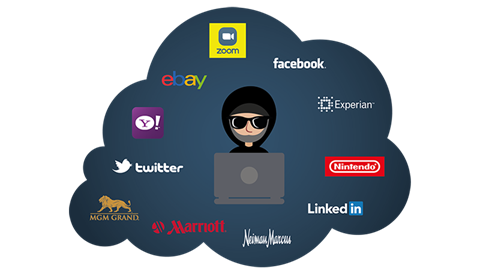In the digital age, identity theft must be understood. When someone obtains another person’s personal information and uses it for fraudulent activities like financial gain or committing crimes in the victim’s name, this is known as identity theft. Identity theft is increasingly frequent and harmful now that we live in a digital age when enormous quantities of personal data are saved and shared online. To gain sensitive information, cyber criminals use social engineering tricks, data breaches, and weaknesses in online systems. 
Identity theft may take many different forms, such as financial identity theft, where thieves use stolen data to create false accounts or conduct unauthorized transactions, and criminal identity theft, when the identity is used to elude authorities or engage in illicit activity. Other forms include medical identity theft, child identity theft, and synthetic identity theft, where criminals combine real and fabricated information to create new identities.
The Dark Web:
A Breeding Ground for Stolen Identities: The dark web, a hidden part of the internet, provides an anonymous platform for cyber criminals to engage in illicit activities. Unlike the surface web, which is indexed and accessible through search engines, the dark web requires special software to access, such as Tor. The anonymity provided by the dark web makes it an ideal environment for identity thieves to operate undetected.
Within the dark web, there are specific marketplaces and forums dedicated to buying and selling stolen identities. These marketplaces offer a wide range of stolen data, including credit card information, social security numbers, login credentials, and more. The transactions often occur using cryptocurrencies, making it harder to trace the flow of money and identities. Additionally, there are tutorials and guides available for aspiring identity thieves, further fueling the growth of this criminal activity.
The Consequences of Identity Theft:
Identity theft can have severe consequences for individuals and businesses alike. Financially, victims may suffer unauthorized transactions, drained bank accounts, or damaged credit scores. They may spend significant time and resources resolving fraudulent activities and restoring their financial reputation. Beyond financial losses, identity theft can cause emotional distress, as victims may feel violated, vulnerable, and anxious about their personal information being misused.
Moreover, identity theft incidents can harm a person’s professional reputation and relationships. For businesses, data breaches resulting from identity theft can lead to legal liabilities, regulatory fines, and reputational damage. Customers may lose trust in the organization’s ability to protect their data, impacting customer retention and brand loyalty. In some cases, businesses may also face legal consequences for failing to adequately secure personal information.
The Importance of Dark Web Monitoring:
Dark web monitoring plays a vital role in combating identity theft by proactively detecting compromised credentials and personal information. By continuously monitoring the dark web, individuals and businesses can stay ahead of cyber criminals, identify potential risks, and take immediate action to mitigate the damage.
Dark web monitoring services utilize sophisticated technologies and techniques to scan the dark web for mentions of stolen information or compromised identities. These services monitor various sources, including dark web marketplaces, forums, social media platforms, and hacker communities. By analyzing the data collected, dark web monitoring services can identify patterns, track the sale and distribution of stolen data, and provide real-time alerts to individuals or businesses whose information has been compromised.
Dark Web Monitoring Techniques and Tools:
Dark web monitoring relies on advanced techniques and tools to gather intelligence on illicit activities. Automated monitoring systems and technologies scan the dark web for keywords, specific data sets, or predefined patterns associated with stolen identities. Web crawling and data scraping techniques are employed to collect data from dark web marketplaces and forums.
In addition to automated monitoring, human intelligence and collaboration play a crucial role. Dark web monitoring services often have partnerships with cybersecurity experts, law enforcement agencies, and other organizations involved in combatting cybercrime. These collaborations provide access to valuable insights, help in tracking down identity thieves, and facilitate the shutdown of illegal operations.
Benefits of Dark Web Monitoring for Individuals:
Individuals can benefit from dark web monitoring by protecting their personal information and financial assets. Monitoring services can alert individuals if their credentials or personal information are detected on the dark web. This early detection allows individuals to take immediate steps, such as changing passwords, notifying financial institutions, or enabling additional security measures, to prevent further unauthorized access.
Dark web monitoring also offers an additional layer of protection when it comes to identity verification. Individuals can monitor the dark web for signs of their personal information being misused, which helps in detecting fraudulent activities, such as account takeovers or the creation of fake accounts in their name. By promptly addressing such incidents, individuals can mitigate potential damage and minimize the impact on their personal and financial lives.
Benefits of Dark Web Monitoring for Businesses:
Businesses face significant risks from identity theft, including financial losses, legal liabilities, and reputational damage. Implementing dark web monitoring as part of their cybersecurity strategy helps businesses protect customer data, comply with data protection regulations, and maintain trust with their clientele.
Dark web monitoring enables proactive threat intelligence, allowing businesses to identify potential data breaches and take prompt action to safeguard sensitive information. By monitoring the dark web for mentions of their company name, employee credentials, or customer data, businesses can quickly identify and mitigate risks. Additionally, dark web monitoring helps organizations detect stolen intellectual property, trade secrets, or compromised internal information, enabling them to take necessary measures to secure their assets.
Implementing Dark Web Monitoring Strategies:
To effectively implement dark web monitoring, individuals and businesses should develop a comprehensive monitoring plan. This includes selecting reliable dark web monitoring services that align with their specific needs and requirements. The chosen service should have robust capabilities to scan and monitor the dark web continuously.
Integration of dark web monitoring with existing security measures is crucial to maximize the effectiveness of the overall cybersecurity strategy. This integration ensures that dark web monitoring is part of a holistic approach to identify, prevent, and respond to cyber threats. Organizations should also establish clear incident response protocols to facilitate timely and effective actions when potential risks are detected.
Regular assessments and updates to the monitoring strategy are essential to staying ahead of evolving threats on the dark web. Cybercriminal tactics and techniques are continually evolving, so it is vital to adapt monitoring strategies accordingly. By staying informed about emerging threats and vulnerabilities, individuals and businesses can enhance their dark web monitoring efforts and better protect themselves against identity theft.
Educating and Raising Awareness:
In addition to implementing dark web monitoring strategies, educating individuals and raising awareness about the risks of identity theft is crucial. Promoting digital literacy, teaching safe online practices, and providing guidance on recognizing and avoiding phishing scams, social engineering, and other tactics used by identity thieves are essential.
Training employees on identifying and reporting potential identity theft incidents within the organization is also crucial. By educating employees about the risks, implementing strong security practices, and fostering a culture of cybersecurity awareness, businesses can strengthen their defense against identity theft and other cyber threats.
Sharing real-life examples and case studies can help illustrate the consequences of identity theft and emphasize the importance of dark web monitoring. Such examples can demonstrate how early detection and swift action can significantly reduce the impact of identity theft incidents. Through education and awareness, individuals and businesses can empower themselves to take proactive measures and protect against the pervasive threat of identity theft.
Conclusion:
Dark web monitoring is a critical tool in combating identity theft in the digital age. By understanding the connection between the dark web and identity theft, individuals and businesses can recognize the importance of monitoring the hidden corners of the internet. With proactive monitoring and timely response, individuals can protect their personal information, while businesses can mitigate risks, preserve their reputation, and maintain the trust of their customers. Dark web monitoring should be an integral part of any comprehensive cybersecurity strategy to safeguard against the pervasive threat of identity theft.


